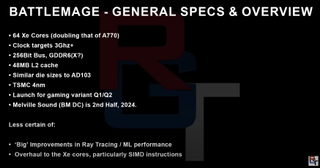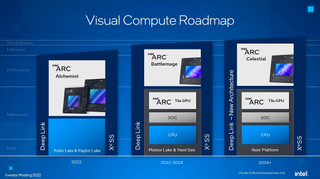Intel's next-gen GPUs absolutely need to match up to these rumoured specs to be relevant
The latest, impressive Intel Battlemage 'leak' may or may not be true, but it had better be for Arc's sake.

A new rumour detailing Intel's next-gen Battlemage GPU has emerged. It's a pretty detailed 'leak' as these things go and would make for a properly quick Intel GPU. More importantly, whether it's entirely made up or based on actual information from inside Intel, it sets a good target for what Intel absolutely must deliver to be relevant when Battlemage arrives next year.
Lest ye have forgotten, Battlemage is Intel's second-gen gaming graphics chip. It's absolutely a real thing appearing on countless official Intel roadmaps and it's due next year. Beyond that, Intel hasn't said much publicly about Battlemage aside from an assertion that its Arc engineers are hard at work on it right now.
But along comes regular rumour monger RedGamingTech to unload an unusually detailed list of specifications and performance metrics. So, let's cut straight to it.
Battlemage is said to fully double up on the Xe core count of the top Alchemist GPU seen on the Intel Arc A770 graphics cards. So, that's 64 Xe cores. It retains the same 256-bit memory bus but triples the L2 cache to 48MB. And it will be built on TSMC's 4nm node and capable of 3GHz-plus clockspeeds.
Along with those headline speeds and feeds, it's expected to get improved ray tracing performance along with redesigned Xe cores that can do more work per clock, adding to the GPU's overall performance.
The overall result? Performance at least on par with Nvidia's RTX 4070 Ti and maybe up with the RTX 4080. The immediate question is whether any of this is true.

That is impossible to say at this stage. However, what we can say is that the specs are both pretty plausible and also very much what Intel needs to deliver to be relevant when Battlemage arrives in 2024.
The biggest gaming news, reviews and hardware deals
Keep up to date with the most important stories and the best deals, as picked by the PC Gamer team.
On the plausibility side, either TSMC 5nm or 4nm are pretty much nailed on to be the production node Intel will use. They're closely related and they're what AMD and Nvidia already use for their GPUs.
The doubling of Xe cores is quite aggressive by industry standards. It's not that often a new GPU fully doubles up on the previous generation. But Intel both needs to close the gap and also went fairly conservative with Alchemist. So, there's scope for that kind of increase in functional units for sure.
Ditto the 48MB of L2 cache. GPU cache is becoming increasingly important, so a big boost there makes sense. So does the carry-over 256-bit bus. We're not expecting Battlemage to compete right at the bleeding edge with Nvidia's very fastest GPUs, so a 256-bit bus is very plausible rather than something bigger like the 384-bit bus of the Nvidia RTX 4090.

If anything seems particularly ambitious, it's the promised 3GHz clock speed. Alchemist tops out at 2.1GHz on TSMC 7nm, while the quickest of Nvidia's new RTX 40 series GPUs, which use the TSMC 4nm node that Battlemage is said to be built on, max out at just over 2.6GHz. AMD has likewise only managed 2.5GHz with its latest Radeon RX 7900 XTX GPU via TSMC's 5nm node.
Whatever, Nvidia's RTX 4070 Ti as a minimum target next year makes sense. Dramatically faster than that GPU seems like a tall order. But much less and Intel risks being left behind again.
Remember, Nvidia will almost certainly release another brand new generation of GPUs, likely branded the RTX 50-series late next year. If Intel can't match a 4070 Ti before then, it will be miles behind when Nvidia launches its new chips.
Moreover, to match a 4070 Ti it will need to double the performance of the Arc A770 plus a bit. Which is pretty much what you'd expect if you double all the Alchemist's functional units, make them each a bit more powerful, and then up the clocks a bit.
So, no we can't confirm if this rumour is true. But we can say that it's very much what Intel needs to deliver with Battlemage to be relevant.
Best CPU for gaming: Top chips from Intel and AMD
Best gaming motherboard: The right boards
Best graphics card: Your perfect pixel-pusher awaits Best SSD for gaming: Get into the game first

Jeremy has been writing about technology and PCs since the 90nm Netburst era (Google it!) and enjoys nothing more than a serious dissertation on the finer points of monitor input lag and overshoot followed by a forensic examination of advanced lithography. Or maybe he just likes machines that go “ping!” He also has a thing for tennis and cars.
Most Popular








